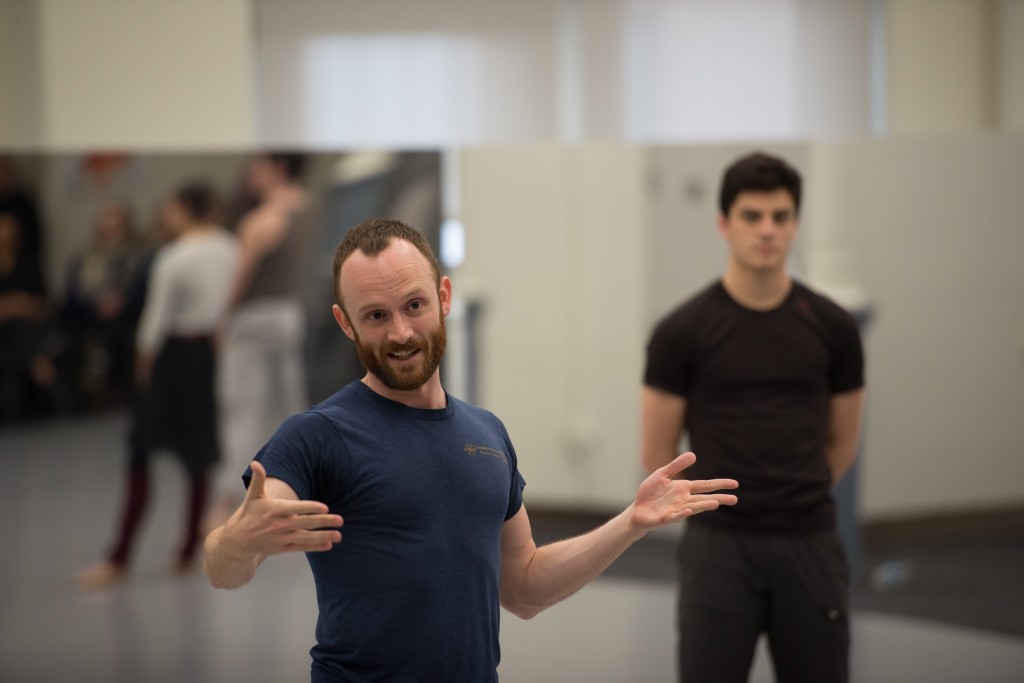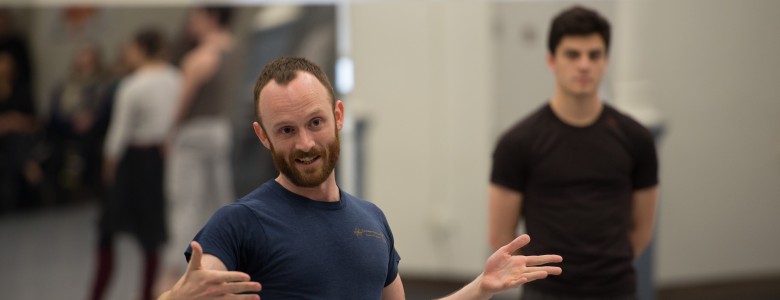The Pennsylvania Ballet will be the first American ballet company to learn Trisha Brown’s O zlozony / O composite (performances June 9–12 tickets/info), a 2004 trio made for the Paris Opera Ballet. These essays, written by long time Trisha Brown Company dancer Neal Beasley, detail the experience of setting Brown’s work on the Pennsylvania Ballet dancers.
On my first day back in Philadelphia after a three-week break from rehearsals, I pass one of the dancers from the Company on my walk to the studio. She is on her typical route, on a typical Monday, crossing a heavily trafficked bridge on North Broad Street. While there is nothing out of the ordinary about this moment, seeing her—and as simple as it sounds—I am struck by the thought that for the three weeks I have been absent she has been doing exactly this. She hasn’t left. This is where she lives and works, her home. I am suddenly aware of my own transience, of my position at the periphery of life here. She is in her element, in the comfort of familiarity and routine. I am walking into a world that has been moving along without me.
Being on the outside affords me a particular vantage point, allowing me to see, ideally, those things which comfort and familiarity can obscure. As I walk into the week, I am somewhat unsure of the state in which I’ll find the piece we’ve been rehearsing. My work is to watch, notice, and comment: to look for and articulate the things that make this dance and these dancers what and who they are. My job is to pay attention.
As we begin again my own body feels different, less ready to move. The energy in the room is more static; we step more politely around one another and stare more blankly. It takes time to remember how to talk and work with one another. I am conscious of the time that has passed, of a certain stiffness that needs massaging out of the room. We are warming up, relocating the stride in our working process.

Every day this week Aaron Anker and I work one-on-one on the solo section he is performing. He is the only dancer in the cast with whom I have such regular contact, though only for small, half hour blocks of rehearsal. As the week progresses, I am amazed at what happens as we examine this solo again and again, taking the time to return to something that is already known. With each day we become more aware of nuance, noticing exactly where things are not quite working and beginning to articulate why. We are honing our attention, attune to increasingly subtle layers, accumulating more and more detail. By week’s end, it almost looks like a different solo, and Aaron almost like a different dancer. It’s remarkable what time and focus can do, in ways that I still find surprising.
Now we leave behind the broad strokes of fitting together the skeleton of the dance and pull out a magnifying glass to address the precision work, the details. On our first day of rehearsal, things seem slightly out of tune, like guitar strings that have lost their tautness from lack of use. It occurs to me that the dancers aren’t really thinking about their breathing, that there’s something mechanical about the way they move from shape to shape. But the simple act of placing some attention on the breath begins to change things. They relax their grip on one another and on the choreography. Things fit together more smoothly. The dancing sings again in its quiet, low hum.
When Stephen Petronio was watching our last day of rehearsal before the break, he noted that many of the interactions and partnering in the choreography are almost polite, that bodies are woven together like lace: a hand slipping into the space created between a torso and a bent elbow, a caress that folds a leg and places it on the floor. O zlozony / O composite is a very quiet work. Many moments float and drift, skimming the surface of the floor rather than pushing against it. The magic comes from hitting a sweet spot of energy and phrasing: not too tight and not too loose. Our work this week has been an attempt to define what exactly makes that quality possible, and to understand how to live inside and create the dance’s very particular tone.
Yet as our focus travels inward towards tiny, often unseen moments in the choreography, there is a simultaneous widening of perspective, out towards the space of the stage and the act of performance. Conversations about how these bodies exist together, about where and how the dancers use their eyes, especially when looking at one another, about how to express a certain consciousness and care without drifting into the melodramatic—these questions pepper the rehearsal day. I’ve always loved this part. It always feels like a real privilege and the point of the whole enterprise. Everything leads up to this place, all the conversations about technique, timing, dynamics—these function in service of the moment when a dance takes on a life of its own, when any information I have becomes the property of the bodies who will be performing. Our rehearsal process takes on its own kind of breathing, expanding to the fullness of performance and contracting in on the minutiae that remain to be finessed. It all becomes like a game of what we can notice, how finely wrought our attention can be as we bear witness to the moment when a dance comes to life.
Photo: Neal Beasley in studio with Aaron Anker. Photo by Johanna Austin.

